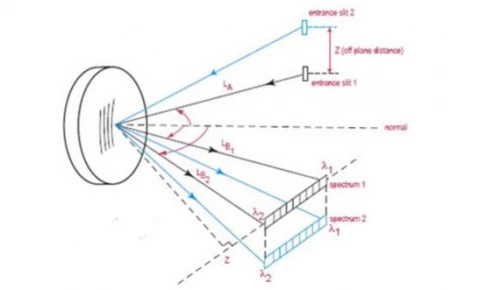Flat Field and Imaging Grating 533 00 610
Description
Type IV aberration corrected flat field and imaging gratings are designed to focus a spectrum onto a plane surface, making them ideal for use with linear or 2-D array detectors. These gratings are produced with grooves that are neither equispaced nor parallel, and are computer optimized to form near-perfect images of the entrance slit on the detector plane.
Owing to their large optical numerical aperture and correction from aberrations, these Type IV aberration corrected flat field & imaging
gratings provide much better light collection efficiency and signal to noise ratio than traditional Type I Rowland circle concave gratings.
When an area detector such as a CCD is utilized, it is often possible to focus multiple sources onto the entrance slit and independently evaluate the spectrum from each source. These “Imaging Gratings” are nearly free from astigmatism, and therefore only one fixed optical element is required to construct an imaging spectrograph.
Flat Field and Imaging Grating 533 00 610
Specifications |
|
|---|---|
| Dispersion: | 40 nm/mm |
| Wavelength Range: | 330-780nm |
| Spectrum Length: | 11.3 mm |
| F/Number: | 3.5 |
| Groove Density: | 250 l/mm |
Applications
- Spectrographs
- Spectroscopy
- Laser Optics
- Imaging
For pricing, technical or any other questions please contact the supplier
- No registration required
- No markups, no fees
- Direct contact with supplier
-
Ships from:
United States
-
Sold by:
-
On FindLight:
since 2016
Frequently Asked Questions
Owing to their large optical numerical aperture and correction from aberrations, they provide much better light collection efficiency and signal to noise ratio than traditional Type I Rowland circle concave gratings.
They are produced with grooves that are neither equispaced nor parallel, and are computer optimized to form near-perfect images of the entrance slit on the detector plane.
Type IV gratings provide better light collection efficiency and signal to noise ratio due to their large optical numerical aperture and correction from aberrations.
They are designed to focus a spectrum onto a plane surface, making them ideal for use with linear or 2-D array detectors.
They are suitable for use in spectrographs, spectroscopy, laser optics, and imaging.
